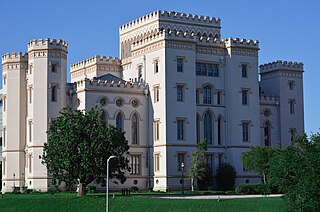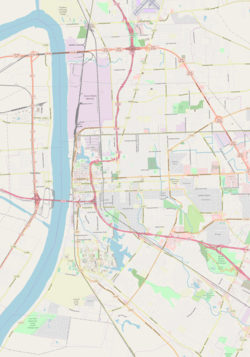
Baton Rouge is the capital city of the U.S. state of Louisiana. Located on the eastern bank of the Mississippi River, it is the parish seat of East Baton Rouge Parish, Louisiana's most populous parish. Since 2020, it has been the second-largest city in Louisiana after New Orleans; Baton Rouge is the 18th-most-populous state capital. According to the 2020 United States census, the city-proper had a population of 227,470; its consolidated population was 456,781 in 2020. The city is the center of the Greater Baton Rouge area—Louisiana's second-largest metropolitan area—with a population of 870,569 as of 2020, up from 802,484 in 2010. Baton Rouge is the fourth most populous city proper in the Deep South region of the southeastern United States.

McKinley Senior High School, located in Baton Rouge, Louisiana, United States on 800 E. McKinley St., is home to the East Baton Rouge Parish School Board's first gifted and talented high school programs. The school mascot is a Panther and the school colors are royal blue and white.

The Louisiana State Capitol is the seat of government for the U.S. state of Louisiana and is located in downtown Baton Rouge. The capitol houses the chambers for the Louisiana State Legislature, made up of the House of Representatives and the Senate, as well as the office of the Governor of Louisiana. At 450 feet (137 m) tall and with 34 stories, it is the tallest skyscraper in Baton Rouge, the seventh tallest building in Louisiana, and tallest capitol in the United States. It is located on a 27-acre (110,000 m2) tract, which includes the capitol gardens. The Louisiana State Capitol is often thought of as "Huey Long's monument" due to the influence of the former Governor and U.S. Senator in getting the capitol built. The building's construction was completed in 1931. It was listed on the National Register of Historic Places in 1978 and was designated a National Historic Landmark in 1982.
The Garden District is a residential neighborhood located in Baton Rouge's Mid-City area where Park Boulevard intersects Government Street. The Garden District is an established historic area with many upscale homes and an active civic association.

Beauregard Town, also known as Beauregard Town Historic District, is a historic district in downtown Baton Rouge, Louisiana, anchored by Government Street. It was commissioned in 1806 by Elias Beauregard, and was listed on the National Register of Historic Places in 1980. It is the second-oldest neighborhood in Baton Rouge.

The Old Louisiana State Capitol, also known as the State House, is a historic government building, and now a museum, at 100 North Boulevard in Baton Rouge, Louisiana, U.S.A. It housed the Louisiana State Legislature from the mid-19th century until the current capitol tower building was constructed from 1929-32.

Baton Rouge station is a historic train station located at 100 South River Road in downtown Baton Rouge, Louisiana. It was built for the Yazoo and Mississippi Valley Railroad which got absorbed by the Illinois Central Railroad. The station was a stop on the Y&MV main line between Memphis, Tennessee and New Orleans, Louisiana. The building now houses the Louisiana Art and Science Museum.

The Pentagon Barracks, also known as the Old United States Barracks, is a complex of buildings located at the corner of State Capitol Drive and River Road in Baton Rouge, Louisiana, in the grounds of the state capitol. The site was used by the Spanish, French, British, Confederate States Army, and United States Army and was part of the short-lived Republic of West Florida. During its use as a military post the site has been visited by such notable figures as Zachary Taylor, Lafayette, Robert E. Lee, George Custer, Jefferson Davis, and Abraham Lincoln.

The Magnolia Mound Plantation House is a French Creole house constructed in 1791 near the Mississippi River in Baton Rouge, Louisiana. Many period documents refer to the plantation as Mount Magnolia. The house and several original outbuildings on the grounds of Magnolia Mound Plantation are examples of the vernacular architectural influences of early settlers from France and the West Indies. The complex is owned by the city of Baton Rouge and maintained by its Recreation Commission (BREC). It is located approximately one mile south of downtown.

Magnolia Cemetery is a 10-acre (4.0 ha) cemetery in Baton Rouge, Louisiana.

The Masonic Temple Building, built in 1907, is an historic Prince Hall Masonic building located at 427 South Blount Street in Raleigh, North Carolina. It is a three-story, red brick flat roofed building. It has a metal cornice at the top of the first floor level and a cast iron Corinthian order column at the corner. On May 3, 1984, it was added to the National Register of Historic Places.

This is a list of the National Register of Historic Places listings in East Baton Rouge Parish, Louisiana.
Prince Hall Masonic Temple may refer to:

The U.S. Post Office and Courthouse-Baton Rouge, also known as Federal Building and U.S. Courthouse, in Baton Rouge, Louisiana, was built in 1932. It includes Art Deco and Moderne architecture. It served historically as a post office, as a courthouse, and as a government office building.

St. Joseph Cathedral is a Catholic cathedral located in downtown Baton Rouge, Louisiana, United States. It is the mother church of the Diocese of Baton Rouge, and it was listed on the National Register of Historic Places on March 22, 1990.

Edward Fairfax Neild Sr., was an American architect originally from Shreveport, Louisiana. He designed the Harry S. Truman Presidential Library and Museum in Independence, Missouri. He was selected for the task by U.S. President Harry Truman.

The St. James Episcopal Church, located in downtown Baton Rouge, Louisiana, is a congregation of the Episcopal Diocese of Louisiana. Although Episcopalians began gathering in 1819, St. James Church formally organized as an Episcopal congregation in 1844 due to the influence and support of Margaret MacKall Taylor, wife of president Zachary Taylor. Within the spectrum of worship styles in the Anglican tradition, St. James Church was a Low Church parish during the 19th century, but has been considered a Broad Church parish since the early to mid 20th Century. In addition to worship, St. James Church is actively involved in service to the community, pastoral care, and Christian education for all ages. The church is also home to a two-time National Blue Ribbon day school.

The Reiley-Reeves House is a historic house located in the Garden District of Baton Rouge, Louisiana, at 810 Park Avenue.

The Baton Rouge City Club, also known as the Old Post Office, is a historic three-story building at 355 North Blvd in Baton Rouge, Louisiana. It was built in 1895 as a U.S. post office building.




















